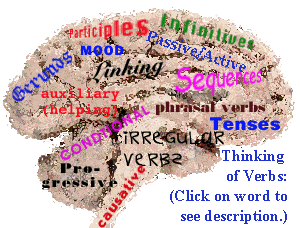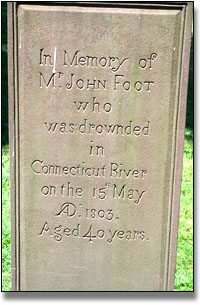


There are separate sections on
Verbs carry the idea of being or action in the sentence.
As we will see on this page, verbs are classified in many ways. First, some verbs require an object to complete their meaning: "She gave _____ ?" Gave what? She gave money to the church. These verbs are called transitive. Verbs that are intransitive do not require objects: "The building collapsed." In English, you cannot tell the difference between a transitive and intransitive verb by its form; you have to see how the verb is functioning within the sentence. In fact, a verb can be both transitive and intransitive: "The monster collapsed the building by sitting on it."
Although you will seldom hear the term, a ditransitive verb — such as cause or give — is one that can take a direct object and an indirect object at the same time: "That horrid music gave me a headache." Ditransitive verbs are slightly different, then, from factitive verbs (see below), in that the latter take two objects.
Verbs are also classified as either finite or non-finite. A finite verb makes an assertion or expresses a state of being and can stand by itself as the main verb of a sentence.
Non-finite verbs (think "unfinished") cannot, by themselves, be main verbs:
Another, more useful term for non-finite verb is verbal. In this section, we discuss various verbal forms: infinitives, gerunds, and participles.
For WebCT Users |
The inflections (endings) of English verb forms are not difficult to remember. There are only four basic forms. Instead of forming complex tense forms with endings, English uses auxiliary verb forms. English does not even have a proper ending for future forms; instead, we use auxiliaries such as "I am going to read this afternoon." or "I will read." or even "I am reading this book tomorrow." It would be useful, however, to learn these four basic forms of verb construction.
| Name of verb | Base form | Past form | Present participle | Past participle |
| to work | I can work. I work. | I worked. | I am working. | I have worked. |
| to write | I can write. I write. | I wrote. | I am writing. | I have written. |
A linking verb connects a subject and its complement. Sometimes called copulas, linking verbs are often forms of the verb to be, but are sometimes verbs related to the five senses (look, sound, smell, feel, taste) and sometimes verbs that somehow reflect a state of being (appear, seem, become, grow, turn, prove, remain). What follows the linking verb will be either a noun complement or an adjective complement:
A handful of verbs that reflect a change in state of being are sometimes called resulting copulas. They, too, link a subject to a predicate adjective:
| "This is he." |
There is now a separate section dealing with issues raised by a verb's VOICE (active/passive).
Mood in verbs refers to one of three attitudes that a writer or speaker has to what is being written or spoken. The indicative mood, which describes most sentences on this page, is used to make a statement or ask a question. The imperative mood is used when we're feeling sort of bossish and want to give a directive, strong suggestion, or order:
Notice that there is no subject in these imperative sentences. The pronoun you (singular or plural, depending on context) is the "understood subject" in imperative sentences. Virtually all imperative sentences, then, have a second person (singular or plural) subject. The sole exception is the first person construction, which includes an objective form as subject: "Let's (or Let us) work on these things together."
The subjunctive mood is used in dependent clauses that do the following: 1) express a wish; 2) begin with if and express a condition that does not exist (is contrary to fact); 3) begin with as if and as though when such clauses describe a speculation or condition contrary to fact; and 4) begin with that and express a demand, requirement, request, or suggestion. A new section on the uses of the Conditional should help you understand the subjunctive.
The subjunctive is not as important a mood in English as it is in other languages, like French and Spanish, which happen to be more subtle and discriminating in hypothetical, doubtful, or wishful expressions. Many situations which would require the subjunctive in other languages are satisfied by using one of several auxiliary verbs in English.
| The New York Public Library's Writer's Guide to Style and Usage has this important note on the subjunctive: "The words if, as if, or as though do not always signal the subjunctive mood. If the information in such a clause points out a condition that is or was probable or likely, the verb should be in the indicative mood. The indicative tells the reader that the information in the dependent clause could possibly be true" (155). Cited with permission. |
The present tense of the subjunctive uses only the base form of the verb.
The past tense of the subjunctive has the same forms as the indicative except (unfortunately) for the verb to be, which uses were regardless of the number of the subject.
An excellent resource for learning more about the subjunctive is available in the online American Heritage Book of English Usage.
The issues raised by Helping or Auxiliary Verbs and Modal Auxiliaries are covered in a separate section. Click here for help with Auxiliary Verbs and Modal Auxiliaries.

Phrasal verbs consist of a verb and another word or phrase, usually a preposition. The resulting combination creates what amounts to a new verb, whose meaning can sometimes be puzzling to non-native speakers. Phrasal verbs often arise from casual uses of the language and eventually work themselves into the mainstream of language use. Phrasal verbs can be both intransitive (The children were sitting around, doing nothing. The witness finally broke down on the stand.) and transitive in meaning (Our boss called off the meeting. She looked up her old boyfriend.) The word that is joined with a verb in this construction (often a preposition) is called a particle.
The problem with phrasal verbs is that their meaning is often, at first, obscure, and they often mean several different things. To make out, for instance, can mean to perceive or to see something; it can also mean to engage in light sexual play. If someone chooses to turn up the street that is a combination of a verb and a preposition, but it is not a phrasal verb. On the other hand, if your neighbors unexpectedly turn up (appear) at a party or your brother turns up his radio, those are phrasal verbs. To come out, we are told, has eighteen different meanings.
Verbs can be combined with different prepositions and other words, sometimes with dizzying effect: stand out, stand up, stand in, stand off, stand by, stand fast, stand pat, stand down, stand against, stand for. Further, the verb and the word or phrase it connects to are not always contiguous: "Fill this out," we would say, but then we would say, "Fill out this form."
You can click HERE for an extensive list of phrasal verbs, broken down into categories of transitive and intransitive, separable and inseparable. The list of verbs is accompanied with brief definitions and examples. Printed out, the list will be five or six pages long, depending on the size font you are using, the width of your browser window, etc. Understand, however, that the list is a mere sampling of the hundreds of phrasal verb combinations. For beginning language learners, the challenge of mastering phrasal verbs is so great that only intensive instruction and practice in an ESL program and a great deal of time spent listening and reading carefully can address the problem. Having a good dictionary at hand is also helpful.
Causative verbs designate the action necessary to cause another action to happen. In "The devil made me do it." the verb "made" causes the "do" to happen. Here is a brief list of causative verbs, in no particular order: let, help, allow, have, require, allow, motivate, get, make, convince, hire, assist, encourage, permit, employ, force. Most of them are followed by an object (noun or pronoun) followed by an infinitive: "She allows her pet cockatiel to perch on the windowsill. She hired a carpenter to build a new birdcage."
Three causative verbs are exceptions to the pattern described above. Instead of being followed by a noun/pronoun and an infinitive, the causative verbs have, make and let are followed by a noun/pronoun and the base form of the verb (which is actually an infinitive with the "to" left off).
Verbs like make, choose, judge, elect, select, name. are called factitive verbs. These transitive verbs can take two objects, or seem to:

Tense shows the time of a verb's action or being. There are three inflected forms reflected by changes in the endings of verbs. The present tense indicates that something is happening or being now: "She is a student. She drives a new car." The simple past tense indicates that something happened in the past: "She was a student. She drove a new car." And the past participle form is combined with auxiliary verbs to indicate that something happened in the past prior to another action: "She has been a student. She had driven a new car."
Unlike most other languages, English does not have inflected forms for the future tense. Instead, English future forms are created with the use of auxiliaries: "She will be a student. She is going to drive a new car." English can even create the future by using the present tense, "The bus arrives later this afternoon," or the present progressive, "He is relocating to Portland later next month."
For an extensive discussion of the future tense in English, click HERE.
Progressive VerbsThe progressive tenses, which indicate something being or happening, are formed with the present participle form (ending in -ing) along with various auxiliaries. "She is driving. She was driving. She will be driving. She has been driving. She had been driving. She will have been driving." Click HERE for more on the progressive forms. Some verbs, called stative verbs, (including, sometimes, the verb to be) do not normally create the progressive. Click here for a discussion of the difference between stative and dynamic verbs. | For help with the verb "to be," click the enter button below. |
If you have a frames-capable browser, we recommend the
DIRECTORY OF  ENGLISH TENSES ENGLISH TENSES |
The Directory contains descriptions, conjugations (for both regular and irregular verbs), and sample sentences for the twelve tenses of active voice verbs. For a greatly simplified one-page summary of these tenses, click HERE.
Colin Mahoney, a teacher of English as a foreign language, has a considerable page devoted to the Present Perfect Tense (and related issues), which we recommend. For ESL learners and students wanting a thorough review of verbs, we also recommend the tutorial on English tenses at Englishpage.com (expect ads).
Most verbs in English form their various tenses consistently: add -ed to the base of a verb to create the simple past and past participle: he walked; he has walked. There are, however, a number of so-called irregular verbs, (including, unfortunately, some very common verbs such as to be and to have) whose various forms must be memorized. An alphabetized list of Common Irregular Verbs is available in the Guide that you can copy or print out and then try to memorize or at least use in practice sentences. You should take the quizzes on irregular verbs, below, after you've looked at this list.
 Recognizing Verbs: Verbmaster
Recognizing Verbs: Verbmaster Recognizing Verbs: Verbmaster 2
Recognizing Verbs: Verbmaster 2 Irregular Verbs
Irregular Verbs Irregular Verbs II
Irregular Verbs II Irregular Verbs III
Irregular Verbs III Irregular Verbs Crossword Puzzle
Irregular Verbs Crossword PuzzleSequence of Tenses: The relationship between verbs in a main clause and verbs in dependent clauses is important. These verb tenses don't have to be identical as long as they reflect, logically, shifts in time and meaning: "My brother had graduated before I started college." "My brother will have graduated before I start." Click HERE for a chart describing various time relationships and how those relationships determine the appropriate sequence of verb tenses.
Verbals are words that seem to carry the idea of action or being but do not function as a true verb. The are sometimes called "nonfinite" (unfinished or incomplete) verbs. Because time is involved with all verb forms, whether finite or nonfinite, however, following a logical Tense Sequence is important. Click HERE for a chart describing the time elements involved in choosing the correct verbal form. Verbals are frequently accompanied by other, related words in what is called a verbal phrase.
| There is a whole section on how verbals connect with other words to form phrases. Be sure to visit the always pleasant GARDEN OF PHRASES. |
Participle: a verb form acting as an adjective. The running dog chased the fluttering moth. A present participle (like running or fluttering) describes a present condition; a past participle describes something that has happened: "The completely rotted tooth finally fell out of his mouth." The distinction can be important to the meaning of a sentence; there is a huge difference between a confusing student and a confused student. See the section on Adjectives for further help on this issue.
Infinitive: the root of a verb plus the word to. To sleep, perchance to dream. A present infinitive describes a present condition: "I like to sleep." The perfect infinitive describes a time earlier than that of the verb: "I would like to have won that game." See the section on Sequence below for other forms as well.
The Split Infinitive |
If there is one error in writing that your boss or history prof can and will pick up on, it's the notorious split infinitive. An infinitive is said to be "split" when a word (often an adverb) or phrase sneaks between the to of the infinitive and the root of the verb: "to boldly go," being the most famous of its kind. The argument against split infinitives (based on rather shaky historical grounds) is that the infinitive is a single unit and, therefore, should not be divided. Because it raises so many readers' hackles and is so easy to spot, good writers, at least in academic prose, avoid the split infinitive. Instead of writing "She expected her grandparents to not stay," then, we could write "She expected her grandparents not to stay." Sometimes, though, avoiding the split infinitive simply isn't worth the bother. There is nothing wrong, really, with a sentence such as the following:
The Oxford American Desk Dictionary, which came out in October of 1998, says that the rule against the split infinitive can generally be ignored, that the rule "is not firmly grounded, and treating two English words as one can lead to awkward, stilted sentences." ("To Boldly Go," The Hartford Courant. 15 Oct 1998.) Opinion among English instructors and others who feel strongly about the language remains divided, however. Today's dictionaries allow us to split the infinitive, but it should never be done at the expense of grace. Students would be wise to know their instructor's feelings on the matter, workers their boss's. |
Gerund: a verb form, ending in -ing, which acts as a noun. Running in the park after dark can be dangerous. Gerunds are frequently accompanied by other associated words making up a gerund phrase ("running in the park after dark").
Because gerunds and gerund phrases are nouns, they can be used in any way that a noun can be used:
Although they are not, strictly speaking, verbs, infinitives and gerunds carry within them the idea of action. Combined with auxiliary verb forms, like verbs, they also express various shades of time.
Simple
|
|
Perfective
|
|
Passive
|
|
Perfective
|
|
Perfective
|
|
Although a gerund and an infinitive will often have practically the same meaning ("Running in the park after dark can be dangerous" and "To run in the park after dark can be dangerous"), there can be a difference in meaning. Gerunds are used to describe an "actual, vivid, or fulfilled action" whereas infinitives are better used to describe "potential, hypothetical, or future events" (Frodesen & Eyring 297). This is especially true with three kinds of verbs: verbs of emotion, verbs of completion/incompletion, and verbs of remembering.
EMOTION| Actual Event
| Potential Event |
I hated practicing my violin while the other kids were playing outside.
|
I prefer to work during the day. | COMPLETION/INCOMPLETION | Actual Event
| Potential Event |
We began working on this project two years ago. We finished working on this project a month ago. (Finish always takes a gerund.)
|
We will continue to work on this project for the next four months. I wonder when we will start to wrap up this project. | REMEMBERING | (such as remember, forget, regret)
Juanita forgot to do her homework. (meaning that Juanita failed to do her homework because she didn't remember to do it)
|
Juanita forgot doing her homework. (meaning that Juanita did her homework but that she forgot she had done so) | | |||
| For the various noun functions of both gerunds and infinitives, click on the button. | ![[Enter Button]](gif/enter_button.gif)
|
These distinctions for the various kinds of verbs (above) are based on those found in Grammar Dimensions: Form, Meaning, and Use. 2nd Ed. Jan Frodesen and Janet Eyring. Heinle & Heinle: Boston, 1997. Examples our own.
| For additional help recognizing and working with verbs and verb forms, see Chapter 2 of Sentence Sense: A Writer's Guide. |